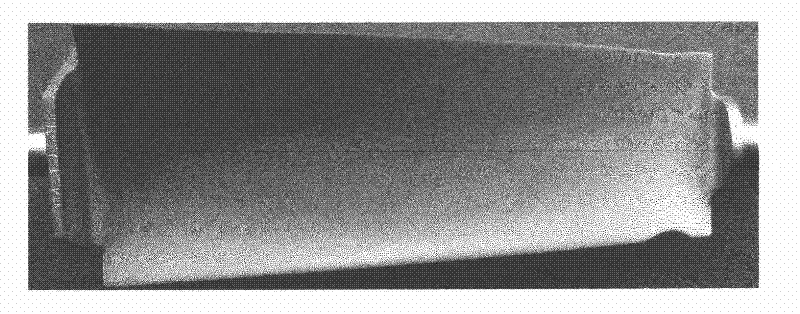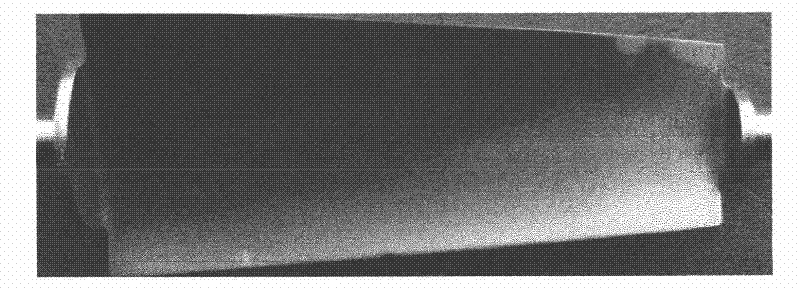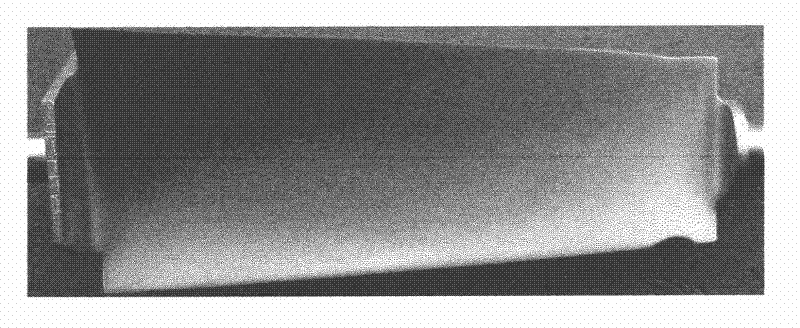Method for macro-etching detection of titanium alloy blade metallurgical quality
A low-magnification corrosion and titanium alloy technology, which is applied in the direction of optical testing for defects/defects, can solve problems such as streamlines and microstructures, mechanical properties and performance, engine reliability blind spots, etc., to achieve perfect technical standards, shorten Cycle time and the effect of improving productivity
- Summary
- Abstract
- Description
- Claims
- Application Information
AI Technical Summary
Problems solved by technology
Method used
Image
Examples
Embodiment 1
[0022] This embodiment provides a method for inspecting the metallurgical quality of titanium alloy blades by low-magnification corrosion, which is characterized in that: the method for inspecting the metallurgical quality of titanium alloy blades by low-magnification corrosion includes, during the blade forming process, including: extruding rods, Heading, pre-forging, isothermal forming, isothermal correction, heat treatment, machining, low-magnification corrosion; vacuum heat treatment: double annealing, heating at 900°C, heat preservation, heat preservation time calculated according to the largest cross-section; cooling with argon; heating at 550°C , heat preservation for 4 hours, filled with argon to cool; machining method: CNC machining; low-magnification corrosion bath solution: HF (42%) 120ML / L, HNO 3 (65%~68%)260ML / L, H 3 PO 4 (85%) 160ML / L, urea 25g / L, others are water;
[0023] If the uniform equiaxed α-phase structure is the ideal structure, then the heterogeneous...
Embodiment 2
[0035] This embodiment provides a method for inspecting the metallurgical quality of titanium alloy blades by low-magnification corrosion, which is characterized in that: the method for inspecting the metallurgical quality of titanium alloy blades by low-magnification corrosion includes, during the blade forming process, including: extruding rods, Heading, pre-forging, isothermal forming, isothermal correction, heat treatment, machining, low-magnification corrosion; vacuum heat treatment: double annealing, heating at 920°C, heat preservation, heat preservation time calculated according to the largest cross-section; cooling with argon; heating at 650°C , heat preservation for 8h, filled with argon to cool; machining method: CNC machining; low-magnification corrosion bath solution: HF (42%) 120ML / L, HNO 3 (65%~68%)260ML / L, H 3 PO 4 (85%) 160ML / L, urea 25g / L, others are water;
[0036] If the uniform equiaxed α-phase structure is the ideal structure, then the heterogeneous micr...
Embodiment 3
[0048] This embodiment provides a method for inspecting the metallurgical quality of titanium alloy blades by low-magnification corrosion, which is characterized in that: the method for inspecting the metallurgical quality of titanium alloy blades by low-magnification corrosion includes, during the blade forming process, including: extruding rods, Heading, pre-forging, isothermal forming, isothermal correction, heat treatment, machining, low-magnification corrosion; vacuum heat treatment: double annealing, heating at 910°C, heat preservation, heat preservation time calculated according to the largest cross-section; cooling with argon; heating at 600°C , heat preservation for 6h, filled with argon to cool; machining method: CNC machining; low-magnification corrosion bath solution: HF (42%) 120ML / L, HNO 3 (65%~68%)260ML / L, H 3 PO 4 (85%) 160ML / L, urea 25g / L, others are water;
[0049] If the uniform equiaxed α-phase structure is the ideal structure, then the heterogeneous micr...
PUM
 Login to View More
Login to View More Abstract
Description
Claims
Application Information
 Login to View More
Login to View More - R&D
- Intellectual Property
- Life Sciences
- Materials
- Tech Scout
- Unparalleled Data Quality
- Higher Quality Content
- 60% Fewer Hallucinations
Browse by: Latest US Patents, China's latest patents, Technical Efficacy Thesaurus, Application Domain, Technology Topic, Popular Technical Reports.
© 2025 PatSnap. All rights reserved.Legal|Privacy policy|Modern Slavery Act Transparency Statement|Sitemap|About US| Contact US: help@patsnap.com



